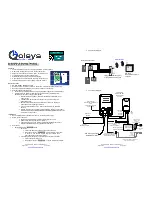
Floppy disks feature a protection tab that safeguard valuable data and prevent accidental cancellation. To remove
the protection and be able to write on the disk, slide the plastic tab upwards, closing the hole. To protect the Floppy
Disk so that it is not possible to erase or overwrite the contents, slide the plastic tab downwards, opening the hole.
You can use a pen or a pointed object to slide the tab.
GENERAL DISK-HANDLING TIPS
If this is the fi rst time you use a Floppy Disk and do not feel comfortable about handling such delicate mag-
netic aids, read this section very carefully.
INSERTING A FLOPPY DISK INTO THE DRIVE
Floppy Disks are inserted in the disk drive with the lablel side up, and the metallic shutter fi rst in. Push the disk
smoothly and fi rmly until it clicks into place. Hold the disk straight and avoid forcing it in while inserting.
EJECTING A FLOPPY DISK
Before ejecting a Floppy Disk, make sure that the operation led in the drive is OFF, and that wk1000 display shows
no disk operation being in progress. To extract the Disk, press the eject b button utton and remove the disk.
DISK PROTECTION
1
Never open the metal protection shutter or touch the soft surface of the Floppy Disk.
2
Never leave a Floppy Disk inside wk1000 disk drive when you carry the keyboard around. Vibrations may
cause the drive head to scratch the disk and make it useless.
3
Never place Floppy Disks in proximity of TV sets, computer monitors, amplifi er, loudspeakers, power
transformers or other device which is a potential source of magnetic fi eld. The disk contents could be
seriously damaged or lost.
4
Never leave the disks in extremely warm or cold places. Do not expose them to direct sunlight. Protect
them from dust or dirt.
5
Do not place objects on top of a Floppy Disk.
6
Always return a Floppy Disk in a protective case after use.
HANDLING FLOPPY DISKS
Floppy Disks should be handled with great care, to prevent damage or loss of data.
It is advisable to keep a back-up copy of the more valuable Floppy Disks. The back-up copies should be stored
in safe places, as they are of extreme importance in case the data contained either in the instrument or in other
Floppy Disks get lost or damaged. To transfer data from a Floppy Disk to another it is necessary to go through
the instrument RAM memory. The contents of the source Floppy Disk (the one containing the data you want to
back-up) should be fi rst loaded to wk1000 RAM memory, then saved to the destination Floppy Disk (the one you
will keep as a back-up copy)
BACK-UP COPIES
After the instrument has been used for a long period of time, the disk drive head may become dirty, and cause
frequent disk load and disk save errors. To proceed to head cleaning, make sure you will use a good-quality
fl uidtype head cleaning kit for 3.5” double-sided disk drive. Do not use a cleaning kit intended for old single-
sided disk drives.
1. Moisten the cleaning disk with the fl uid product.
2. Insert the cleaning disk into the drive.
3. Execute a loading procedure. An error message will appear. It must
appear, as this is perfectly normal.
4. After about 10 seconds, extract the disk.
WARNING!: Wait at least 5 minutes before using the drive again.
CLEANING THE DISK DRIVE HEAD
1. Never change the fi le extension, since it identifi es the type of fi le and the relative structure.
2. Never use names longer than 8 characters. Furthermore, owing to some limitations of MS-DOS and Atari
systems, it is extremely important to observe the following precautions:
1. Do not insert spaces within a fi le name (e.g.: “MY FILE”). MS-DOS does not recognize fi le names containing
spaces. To keep a fi le name divided into two distincted parts, you can separate the two parts with an “under-
score” symbol (e.g.: “MY_FILE”).
3. Do not assign the same name to two different fi les, even though one is written all in Capitals and the other
with small letters (e.g. “MYFILE” and “myfi le”). MS-DOS and Atari do not distinguish between capital and
small (or uppercase and lowercase) letters.
PRECAUTIONS TO OBSERVE WHEN USING wk1000 DISKS WITH A COMPUTER
As occurs with MS-DOS operating system, wk1000 uses up to 8-character fi lenames, and a 3-char-
acter extension. Macintosh, OS/2 and Windows operating systems may use longer names. When a
fi le is named, or renamed on these computers, the following rules should be followed:
owners manual
wk1000
the disk
Page38















































